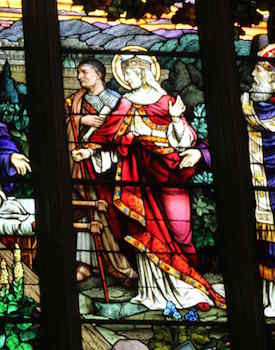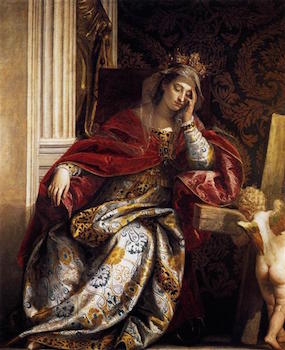
One afternoon in the early forties, the pulp writer Arthur J. Burks was seated in the lobby of a publishing firm in New York when he ran into his friend L. Ron Hubbard. The two authors had been close for years—Burks had seen Hubbard’s unpublished manuscript Excalibur, a work on the mind that he later called “the strangest book I ever read”—and their interests ran along similar lines. With the help of his wife and a second woman, Burks had been experimenting with spiritualism, and the three enthusiasts believed that they were in contact with a number of “monitors,” or spirit guides, who spoke by rapping on a table or through automatic writing. When Burks brought Hubbard home that day, it soon became clear that he was a promising addition to their group. In his occult memoir Monitors, Burks recalls of the man whom he calls “Redhead”:
Almost before we were able to explain anything that was happening to us, [Hubbard] told us this: “I was the first flier in the United States to gain a glider pilot’s license. I loved gliders. But sometimes I took too great chances and found myself in difficulties. I shortly learned, though, that when I was in danger, ‘someone’ looked after me. If I was trying to find the ground through the heart of a thunderstorm, and feared a fatal crash, and looked out to see a smiling woman sitting on one of my wings, I knew I would come through. She was always there, and visible, when I knew myself in great trouble.”
The others exchanged meaningful looks, and one of their “monitors” indicated that he had something to say. When Burks’s spiritual partner finished writing the message, it read: “His monitor is a saint. She was a woman. Tell him what has happened so far.”
According to Burks, they spoke with the spirit world for hours, with another guide providing “the name of Redhead’s monitor, together with historical data about her.” When they were unable to find the name in a dictionary, the monitor told one of the women to leaf through the volume with a pencil, which led to this dramatic moment:
Suddenly she stabbed down the pencil, holding several pages. The topmost page told the story. But the name indicated was an entirely different one! It was indeed the name of a saint, about whom much appeared in the big book. And at the very end of the biographical material appeared this line: “Also called…” And that name was that which had been given us, its middle letter holed by the lead pencil point.
Even if we don’t take Burks’s account at face value, we can add it to our limited stock of information about Hubbard’s guardian spirit. Years later, in the secret autobiographical document known as the “Affirmations,” Hubbard provided a few other details, including her name:
The most thrilling thing in your life is your love and consciousness of your Guardian. She materializes for you. You have no doubts of her. She is real. She is always with you. You love her very much. You trust her. You see and hear her. She is not your master. You have a mighty spiritual will of your own. She is an advisor and as such is respected by you. She is wise and worthy and never changes shape…She has copper red hair, long braids, a lovely Venusian face, a white gown belted with jade squares. She wears gold slippers. Thus you see her…Only Flavia Julia and then the All Powerful have opinions worth inclining toward.

Who was Flavia Julia, and what did she mean to Hubbard? There have been a number of efforts to fill in the blanks, beginning with a letter that the author’s friend Jack Parsons wrote to Aleister Crowley: “[Hubbard] describes his Angel as a beautiful winged woman with red hair whom he calls the Empress and who has guided him through his life and saved him many times.” Hubbard’s estranged son later claimed that his father referred to her as Hathor, while the biographer Jon Atack shrewdly associates her with the goddess Diana, whose name had a special significance to Hubbard. (He named his daughter after her, along with one of his yachts, and Atack even suggests that she also inspired the term “dianetics,” which was officially derived from the Greek roots meaning “through the mind.”) But I think that the one who comes the closest is the journalist Lawrence Wright, who writes in a note in Going Clear:
In the “Affirmations,” Hubbard explicitly names his Guardian Flavia Julia. He may have been referring to Flavia Julia Titi, daughter of the Roman Emperor Titus; or, perhaps more likely, to the Empress Flavia Julia Helena Augustus, also known as Saint Helen, mother of Constantine the Great, who is credited with finding the “True Cross.”
In fact, the association with Saint Helena seems exceptionally convincing. Her full name includes “Flavia Julia”; she’s often depicted in art as a beautiful young woman, although she was at an advanced age when her son converted to Christinaity; and she’s one of the few Roman Catholic saints who could be accurately described as an Empress.
And the clincher is hiding in plain sight. Hubbard spent much of his childhood in Helena, Montana, of which Russell Miller writes in the biography Bare-Faced Messiah:
Helena in 1913 was a pleasant city of Victorian brick and stone buildings encircled by the Rocky Mountains, whose snow-dusted peaks stippled with pines provided a scenic backdrop in every direction. The Capital Building, with its massive copper dome and fluted doric columns, eloquently proclaimed its status as the first city of Montana, as did the construction of the neo-Gothic St. Helena Cathedral, which was nearing completion on Warren Street.
The italics are mine. A few pages later, Miller adds: “Ron was enrolled at the kindergarten at Central School on Warren Street, just across from the new cathedral which, with its twin spires and gray stone facade, towered reprovingly over the city. Most days he was walked to school by his aunts, Marnie and June, who were at Helena High, opposite Central School.” A glance at Google Street View reveals that, even today, if you stand at the entrance of the old Central School and look northeast, you’ll be facing the cathedral’s twin spires, and the most direct route between Hubbard’s house and school would have taken him right by it. Hubbard, in short, spent much of his boyhood—from 1914 to 1921—in the shadow of a cathedral named for Saint Helena. He would have walked past it nearly every day, and if he ever ventured inside, he would have seen the Empress herself depicted in the stained glass window in the north transept. We don’t know why he was so drawn to her, but Saint Helena was best known for her search for relics in the Holy Land, and the story of the vision that led her to the True Cross may well have appealed to a man who would spend years looking for treasure that he had buried in past lives. Hubbard seems to have genuinely believed that she was his guide and protector, and from his point of view, he was perfectly right. She was the patron saint of new discoveries.
from Hacker News https://ift.tt/3ooAzbM
No comments:
Post a Comment
Note: Only a member of this blog may post a comment.